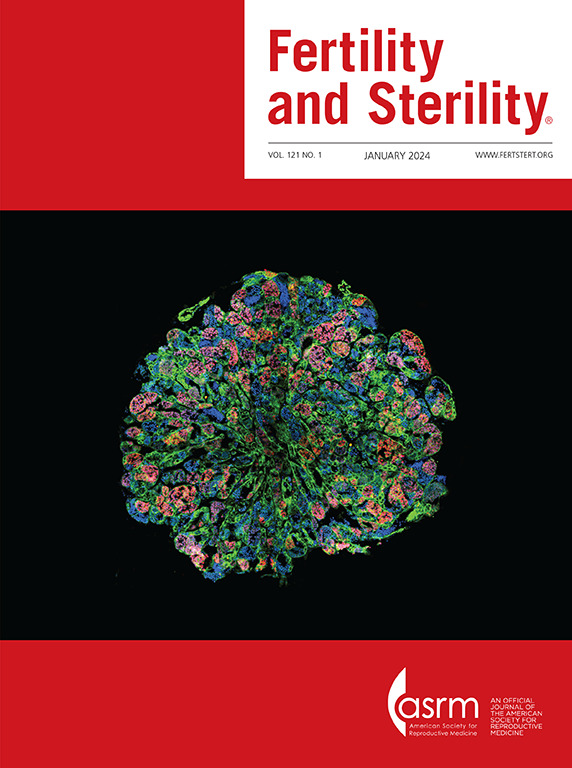The association between primary ovarian insufficiency and increased multimorbidity in a large prospective cohort (Canadian Longitudinal Study on Aging)
IF 6.6
1区 医学
Q1 OBSTETRICS & GYNECOLOGY
引用次数: 0
Abstract
Objective
To describe the prevalence of multimorbidity among individuals with primary ovarian insufficiency (POI) and early menopause compared with those with the average age of menopause.
Design
Prospective cohort.
Subjects
This prospective cohort encompassed female postmenopausal individuals from the Canadian Longitudinal Study on Aging. The Canadian Longitudinal Study on Aging collected cross-sectional data from 50,000 community-dwelling Canadians aged 45–85 years between 2010 and 2015.
Exposure
The primary exposure was POI (defined by onset of menopause at the age of <40 years). Comparators included average age of menopause (age, 46–55 years), early menopause (40–45 years), and late-onset menopause (56–65 years) and those who underwent hysterectomy.
Main Outcome Measure(s)
The primary outcome was multimorbidity, which was defined as two or more chronic conditions. The secondary outcomes were severe multimorbidity (defined as 3 or more chronic conditions) and frequencies of specific chronic conditions among a comprehensive list of 15 individual conditions. We assessed the association between multimorbidity and age at menopause using logistic regression and odds ratios (ORs), with confidence intervals (CIs) set at 95%. The ORs were adjusted for known predictors of multimorbidity, including age, menopausal hormone therapy, education, ethnicity, self-reported loneliness, living alone, body mass index, smoking habits, nutritional risk, social participation, and physical activity.
Result(s)
A total of 12,339 postmenopausal participants were included, of whom 374 (3.0%) experienced POI and 1,396 (11.3%) experienced early menopause. The prevalence rates of multimorbidity were 64.8% and 51.1% among those with POI and early menopause, respectively. In contrast, only 43.9% of individuals with average age of menopause (age, 46–55 years) had multimorbidity. The OR for multimorbidity in the POI population was 2.5 (95% CI, 2.0–3.1) compared with that in individuals who had the average age of menopause. This relationship was maintained after adjustment for confounders (adjusted OR [aOR], 2.0; 95% CI, 1.5–2.5). The prevalence of severe multimorbidity was also double in the POI group compared with that in the average age group (39.2% vs. 21.1%). There were significantly increased risks of ischemic heart disease (aOR, 2.8; 95% CI, 1.7–4.7), gastric ulcers (aOR, 1.6; 95% CI, 1.1–2.3), and osteoporosis (aOR, 1.6; 95% CI, 1.2–2.1) in the POI group.
Conclusion(s)
Individuals with POI and early menopause experience increased multimorbidity compared with those undergoing menopause at an average age. This trend persists even after adjusting for significant multimorbidity risk factors.
Asociación entre insuficiencia ovárica primaria y incremento en la multimorbilidad en un gran cohorte prospectivo (estudio longitudinal canadiense sobre el envejecimiento)
Objetivos
Describir la prevalencia de multimorbilidad en individuos con insuficiencia ovárica primaria (IOP) y menopausia precoz en comparación con aquellos con menopausia en edad promedio.
Diseño
Cohorte Prospectivo.
Setting
Comunidad ambulatoria en diez provincias a lo largo de Canadá, disponible a partir del Estudio Longitudinal Canadiense sobre Envejecimiento.
Paciente(s)
Este estudio de cohorte prospectivo incluye mujeres postmenopáusicas pertenecientes al Estudio Longitudinal Canadiense sobre Envejecimiento. Dicho estudio ha recolectado datos transversales de 50.000 canadienses entre las edades de 45-85 años entre el 2010 y 2015.
Intervención(es)
La variable de exposición fue la IOP (definida como el inicio de menopausia a la edad de <40 años). Las variables de comparación incluyeron edad de menopausia (46-55 años), menopausia temprana (40-45 años), y menopausia tardía (56-65 años) y aquellas que se sometieron a una histerectomía.
Principal Variable(s) de Resultado
La variable principal de resultado fue la multimorbilidad, la cual fue definida como dos o más condiciones crónicas. La variables secundarias de resultado fueron severidad de la multimorbilidad (definida como 3 o más condiciones crónicas) y su frecuencia y condiciones crónicas específicas dentro de una lista comprehensiva de 15 condiciones individuales. Evaluamos la asociación entre multimorbilidad y edad en menopausia usando una regresión logística y odds ratio (ORs), con intervalos de confianza (IC) al 95%. Los OR fueron ajustados utilizando predictores conocidos de multimorbilidad, incluyendo edad, terapia hormonal de menopausia, educación, etnicidad, soledad auto reportada, vivir sola, índice de masa corporal (IMC), hábitos de fumar, riesgo nutricional, participación social, y actividad física.
Resultado(s)
Un total de 12,339 participantes postmenopáusicas fueron incluidas, de las cuales 374 (3.0%) experimentaron IOP y 1.396 (11.3%) experimentaron menopausia temprana. La tasa de prevalencia de multimorbilidad fue de un 64.8% y un 51.1% dentro de aquellas con IOP y menopausia temprana respectivamente. En contraste, solo un 43.9% de individuos con una edad promedio de menopausia (edad, 46–55 años) tenía multimorbilidad. El OR para la multimorbilidad en la población IOP fue de 2.5 (95% CI, 2.0–3.1) en comparación con individuos que tuvieron una edad promedio de menopausia. Esta asociación se mantuvo incluso después de ajustar con variables de confusión (OR ajustados [ORa], 2.0; 95% CI, 1.5–2.5). La prevalencia de la multimorbilidad severa también fue el doble en el grupo IOP en comparación con aquellas en el grupo de edad promedio (39.2% vs. 21.1%). Hubo un incremento significativo del riesgo de isquemia cardíaca (ORa, 2.8; 95% CI, 1.7–4.7), úlceras gástricas (ORa,1.6; 95% CI, 1.1–2.3), y osteoporosis (ORa, 1.6; 95% CI, 1.2–2.1) en el grupo IOP.
大型前瞻性队列中原发性卵巢功能不全与多病症增加之间的关系。
目的描述与平均绝经年龄相比,卵巢早衰(POI)和更年期提前患者的多病患病率:设计:前瞻性队列 受试者:该前瞻性队列包括来自加拿大老龄化纵向研究(CLSA)的绝经后女性。2010年至2015年期间,加拿大老龄化纵向研究收集了5万名居住在社区的45至85岁加拿大人的横断面数据。暴露:主要暴露是原发性卵巢功能不全(定义为绝经年龄小于40岁)。比较者包括平均绝经年龄(46至55岁)、早期绝经(40至45岁)、晚期绝经(56至65岁)以及接受子宫切除术者:主要结果为多病症,即两种或两种以上慢性病。次要结果是严重的多病症(定义为三种或三种以上慢性病),以及在 15 种单个病症的综合清单中特定慢性病的频率。我们使用逻辑回归和几率比(置信区间为 95%)评估了多病症与绝经年龄之间的关系。赔率比根据已知的多病症预测因素进行了调整,包括年龄、更年期激素治疗(MHT)、教育程度、种族、自我报告的孤独感、独居、体重指数、吸烟习惯、营养风险、社会参与和体育锻炼:共纳入了 12339 名绝经后参与者,其中 374 人(3.0%)经历过 POI,1396 人(11.3%)经历过提前绝经。在出现 POI 和更年期提前的人群中,多病患病率分别为 64.8%和 51.1%。相比之下,在平均绝经年龄(46 至 55 岁)的人群中,只有 43.9% 的人患有多种疾病。与平均绝经年龄的人群相比,POI人群的多病症OR值为2.5(95% CI 2.0-3.1)。在对混杂因素进行调整后,这种关系依然存在(aOR 2.0,95% CI:1.5-2.5)。与平均年龄组相比,POI 组的严重多病患病率也增加了一倍(39.2% 对 21.1%)。POI 组患缺血性心脏病(aOR 2.8,95% CI:1.7-4.7)、胃溃疡(aOR 1.6,95% CI:1.1-2.3)和骨质疏松症(aOR 1.6,95% CI:1.2-2.1)的风险明显增加:结论:与平均年龄绝经的人相比,患有 POI 且绝经较早的人的多病症发生率更高。即使对重要的多病症风险因素进行调整后,这一趋势依然存在。
本文章由计算机程序翻译,如有差异,请以英文原文为准。
求助全文
约1分钟内获得全文
求助全文
来源期刊

Fertility and sterility
医学-妇产科学
CiteScore
11.30
自引率
6.00%
发文量
1446
审稿时长
31 days
期刊介绍:
Fertility and Sterility® is an international journal for obstetricians, gynecologists, reproductive endocrinologists, urologists, basic scientists and others who treat and investigate problems of infertility and human reproductive disorders. The journal publishes juried original scientific articles in clinical and laboratory research relevant to reproductive endocrinology, urology, andrology, physiology, immunology, genetics, contraception, and menopause. Fertility and Sterility® encourages and supports meaningful basic and clinical research, and facilitates and promotes excellence in professional education, in the field of reproductive medicine.
 求助内容:
求助内容: 应助结果提醒方式:
应助结果提醒方式:


